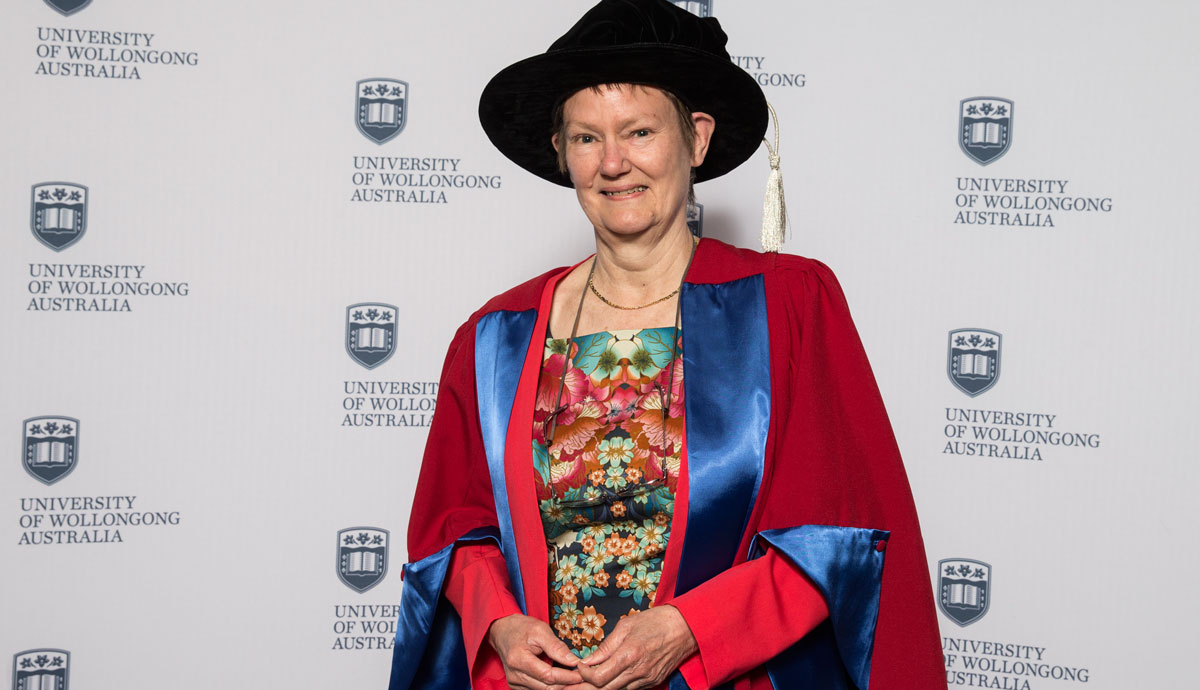April 26, 2016
Earth sciences luminary lights the way for future historical detectives
Pioneering research that has helped unlock secrets held by ancient fossils has been recognised with an honorary doctorate.
UK-based geochronologist Professor Ann Wintle was awarded an honorary Doctor of Science (honoris causa) at the April graduation celebrations (April 26) in recognition of a lifetime of academic service and her valued contribution to UOW through her mentorship and training of budding researchers.
Professor Wintle has been at the forefront of the development of luminescence dating through understanding the fundamental physical properties of luminescence signals from mineral grains, which can indicate the date of important events in the evolution of the Earth and humankind.
This has applications in geology and archaeology and has paved the way for new ways to determine the age of the earliest fossils.
Her interest in the sciences was sparked at an early age, and she credits an inspiring high school physics teacher for helping set her course.
“My early career path was influenced by role models, first by my physics teacher at school who set out an experiment that enabled me to measure the charge on an electron and by one of the early TV archaeologists who I later met,” she said.
“Looking back, I can see how role models play an important role, either directly or indirectly.” Professor Wintle earned her Bachelor of Science from the University of Sussex in 1969, followed by her PhD in 1974 and Doctor of Science in 1997, both from Oxford University.
“During my time as a doctoral student, I was involved in drilling small holes in expensive ceramics in museums and private collections,” she said.
“The powder produced was taken back to the laboratory to measure and thus determine whether the item was made in antiquity or in the past few years.
“This experience brought together my childhood wishes, first to be an archaeologist and then a detective, related to watching TV programs and to reading crime novels.”
Despite opting out of academia after 12 years as a post-doctoral researcher, Professor Wintle was appointed as a lecturer through an unconventional interview process.
“I accepted a bet made by a colleague that I would not go to an academic meeting in London in the fancy dress costume that I had just worn to the departmental party in Cambridge. I did!
“To my amazement, at that meeting I was invited to apply for a job as a lecturer in a geography department.
'So, do not be afraid to be unconventional, but embrace whatever opportunities present themselves.”
Following her appointment as a lecturer, first at Royal Holloway, University of London, and then at Aberystwyth University, she established a laboratory that has been a world leader in dating using optically stimulated luminescence.
She has published more than 180 papers. Her most cited paper has radically changed the understanding of how to measure the luminescence signal accurately in the laboratory, demonstrating the impact of her research.
It has changed the field of optically stimulated luminescence dating to such an extent that it is now the method of choice for archaeologists and geologists working in the geologic time period that covers the last 2.6 million years.
Her career has taken her into university departments of physics, archaeology, botany and geography in England, Canada, Wales and Sweden, bringing into light her commitment to interdisciplinary and transnational research.
Professor Zenobia Jacobs, Head of the School of Earth and Environmental Sciences, said the high regard held for UOW’s Optically Stimulated Luminescence (OSL) laboratory is in no small measure due to Professor Wintle’s past and continuing mentorship and training of researchers in this area of expertise.
“This mentorship and training started as early as 1993 and continues to the present – a collaborative friendship we treasure.”
